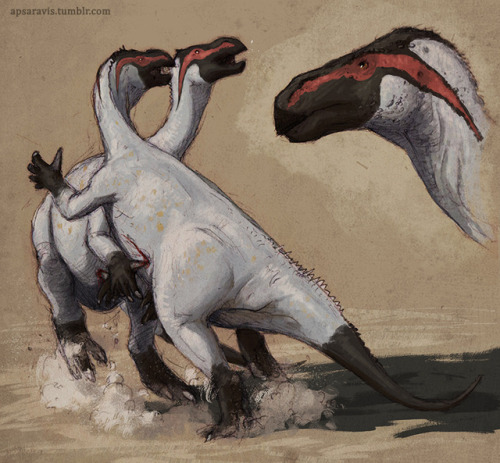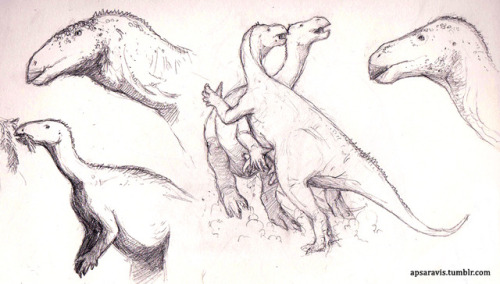#uteodon
Camptosaurus is the most populous species in all of Talenta. While not as diverse or large as the sauropods, they make a successful living by cleaning up after them. Behind the usual gamut of high-browsers which keep the trees from taking over the plains are bison-like herds of camptosaurus browsing on the mid-level vegetation left in their wake. The long, pillar-like legs of the sauropods make bending down an exhausting challenge, so they leave quite a bit for them. Herds can be up to 15,000 members strong and current estimates place the total number alive between 20 and 30 million. While very large and robust compared to cows and deer, they rely on these numbers against the myriad carnivores of Talenta. Allosaurs and Torvosaurus normally prefer sauropods but will double-back to hunt the smaller camptosaurs if need be. Near forests Ceratosaurus will not hesitate to deliver unseen strikes. But the most regular hunters are Marshosaurus and halflings. Smaller than the ginormous sauropods but still large enough to put up a fight, camptosaurus are the primary food-source for most nomadic halflings. Since time immemorial their life-cycles have been intertwined. When the wet season comes, halflings enter a period where hunting is taboo (unless in self-defense), to allow their prey’s numbers to rise once more. Their striped hides are adapted in almost anything made of leather, from tents to saddles to scrolls. Their nature as a facultative biped has also worked its way into their traditions. When going on two legs the camptosaurus is free-game, and when on four legs (normally done to eat or drink) it is considered worse. Its meat will be forever tainted because it was killed in the coward’s position. Hunting camptosaurus is the main method of food acquisition among halflings, also leading to dietary changes. Almost all of their flesh is red meat. Because of this, halflings have an incredibly high tolerance to red meat and usually do not see the health risks associated with it. Camptosaurus is not a domesticated animal, however. Though entwined in their life and death, halflings have never taken them from their herds to breed them. To their minds, it would be an undeserving fate. Hunted wild the beasts can prove their merit in combat. Halfling animal-worship places much importance on the dignity of their bestial neighbors.
Physically similar to camptosaurus, Uteodon is marked by few, noticeable quirks that make it unique. Somewhat larger than their cousins, they possess darker, duller hides and live lonesome lives. Uteodon do not live in herds. Instead they inhabit the forest edges, making equal use of the trees and mid-growing ferns. Halflings consider them to be the camptosaurus’ evil cousin because of their other major difference: their temperament. Uteodon rely on their size and bulk to dissuade predators, but sometimes they need a little extra help understanding. They will bowl over predators in blind charges regardless of whether or not they were looking at the herbivore. Only those too nimble to escape or too large to truly knock over are spared. Which includes the Talenta riders. When hunters see a Uteodon among a herd of camptosaurus, they consider it a bad hunting day. They know it will fight the hunters if they try to hunt anything near it. Smaller camptosaurus herds actively encourage the presence of a single Uteodon in their ranks to defend the rest. Offering a bull first-dibs on any food and water is likely to make it happen. Still, they are rowdy and cantankerous; it’s just as possible they’ll be driven from a herd for accidentally killing a calf. Uteodon-Camptosaurus hybrids are uncommon. They tend to be larger, with dark bodies and dark stripes, and inherit their Uteodon parent’s temperament, but with a better social instinct.
Well, that was a bit of a pause between this and the last Talenta fauna. Anyways, if it wasn’t obvious, Camptosaurus is at the top and Uteodon is at the bottom. Both references come from Scott Hartman. The poses are kind of lazy, but in my defense I haven’t drawn in like a week due to real life complications. With these done we have all of Talenta’s ornithopods (and heterodontosaurs). Where shall we be going next? Perhaps this image contains a hint ^-^
Post link
Just some iguanodonts
- up: fighting Iguanodons
- down: upper left corner - Lanzhousaurs, lower left corner - Uteodon
Post link

Uteodon sleeping on the skull of some past potential predator. All is well in the Jurassic today.
The colors are super vaguely based on masks and horses painted for Día de los Muertos. I know I’m a little late, but a neighborhood near me just had their parade today.



